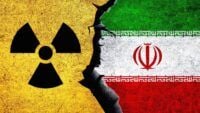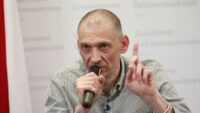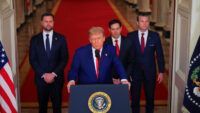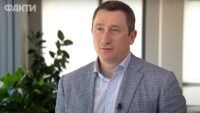
This week, Ukraine found itself at the center of several challenges at once. On the front line, there are attempts by Russian troops to break through and air terror by the occupiers of peaceful cities.
At the same time, in the global context, the world's attention is temporarily shifting. The G7 summit in Canada demonstrated that the main topic, along with the war in Ukraine, was the escalation of the conflict between Israel and Iran.
Does this mean the West will support Ukraine less? How will the escalation in the Middle East affect Ukraine? And what is really behind Putin's new threats?
Now watching
- The situation at the front over the past week
- Massive Russian drone attacks in Ukraine
- The West's Focus on the Middle East
- Putin's threats
- Exchange of prisoners and return of bodies of the dead
- Rada adopted law on multiple citizenship
The situation at the front over the past week
Over the past week, the most tense situation remains in the Donetsk region, in particular around Pokrovsk and Konstantinovka. According to Igor Romanenko , Deputy Chief of the General Staff of the Armed Forces of Ukraine from 2006 to 2010, the enemy is concentrating forces in this area, trying to act in several directions at once.
One of them is southwestern, towards Kurakhovo and Novopavlovka. This movement is rather political in nature: Russian dictator Vladimir Putin wants to create the illusion of advancement towards the Dnipropetrovsk region.
The second – south-eastern – provides access to the Pokrovsk – Konstantinovka highway. The Russians are trying to cover Pokrovsk and Mirnograd, while simultaneously advancing to Konstantinovka.
The offensive plan includes a strike from three sides – Pokrovsk, Toretsk and Chasovy Yar. Meanwhile, the Ukrainian defenders are trying to stop the enemy's advance.
ICTV Live Latest News How Tehran Can Respond to US Strikes on Iran

Tikhanovsky declared his support for Ukraine and explained why he went to occupied Crimea

Where is the Strait of Hormuz and how will its blockage affect the oil market?

US strikes Iran's nuclear facilities: what is known

Chernyshov returned to Ukraine: what is known


Graphics: our website
The deputy director of the Ukrainian Center for Army, Conversion and Disarmament Studies Mykhailo Samus also spoke about the situation in the Donetsk region on the air of the United News telethon. According to him, in the direction of Druzhkovka, in the context of the situation around Pokrovsk, Russian troops are trying to create the preconditions for a breakthrough of the front.
If successful, they will be able to choose several directions for further attack – either to cut off the logistics routes to Konstantinovka or Pokrovsk. This also creates a potential threat to Toretsk, which remains under Ukrainian control.
There is unrest in other areas as well. Romanenko said that active military actions continue in the Kupyansk area, as well as in the Kherson, Liman and Zaporizhzhya directions.
Regarding the situation in Sumy Oblast, Samus said that the situation is gradually stabilizing, although it is too early to talk about complete stability – Russian troops continue their offensive. Their goal is to get closer to the artillery range of Sumy itself in order to carry out further shelling.
However, the enemy's advance is hampered by the terrain. In particular, after reaching the line near Yunakovka, forests begin, which significantly complicate further actions by the Russians.

Graphics: our website
Massive Russian drone attacks in Ukraine
In recent weeks, Russia has significantly stepped up its air attacks on Ukraine, making extensive use of Shahed-type kamikaze drones.
On the night of June 17 alone, the occupiers launched more than 440 drones and 32 missiles. Kyiv suffered the most – one entrance to a multi-story building was completely destroyed, damage was recorded in eight districts of the capital, 28 people died. Odessa, Zaporizhia, Chernihiv, Zhitomir, Kirovohrad, Nikolaev and Kiev regions were also attacked.
Political scientist and head of the board of the Center for Applied Political Research Penta Volodymyr Fesenko noted that at first the enemy carries out massive attacks with hundreds of drones for several days, then there is a certain pause, the shelling does not stop, but the number of drones decreases to 60-70 per day. After the arsenal has accumulated, the attacks are repeated with renewed vigor.
As the expert noted, Russia's tactics are similar to those of Israel and Iran. If Putin previously attacked Ukrainian energy, now he is attacking infrastructure and military facilities.
— That is, he (Putin, – Ed. ) understands that Ukraine is not as dependent now as it will be in 2022-2023 on weapons from international partners. We need it, but there is no such critical dependence, — Fesenko said, adding that Ukraine produces a lot of weapons on its own, so the Kremlin is trying to destroy the military industry and infrastructure.
However, according to him, this strategy has not only a military but also a psychological goal: to demoralize the population and provoke a new wave of emigration from Ukraine, which is already pressure on Europe.
– This is also an attempt to provoke panic among Ukrainians. Ultimately, to push at least part of our population to the idea that it is necessary to agree to the conditions of the Russian Federation in order to end this war, – added Vladimir Fesenko.
At the same time, Mikhail Samus notes that Russia is betting on the Shaheds as the main instrument for changing the situation, even geopolitically. He emphasized the need to create conditions for strengthening air defense, in particular with interceptor drones.
Of particular concern is the fact that Russia is increasing drone production through cooperation with North Korea – satellite images already show new production facilities, and Moscow and Pyongyang have resumed rail links to exchange resources and labor.
Recently, it was reported that Kim Jong-un will send 25,000 of his citizens to a drone manufacturing facility in Russia's Tatarstan in exchange for technology and training in operating drones. This, as Samus noted, could lead to an even greater increase in the number of drones.
The West's Focus on the Middle East
This week, at the G7 summit in Canada, in addition to the war in Ukraine, the escalating situation between Israel and Iran was discussed. US President Donald Trump left the summit early, raising concerns: does this mean that Western attention is shifting from Ukraine to other hot spots?
Political scientist Volodymyr Fesenko said that the West's attention has indeed shifted, but not because of indifference to Ukraine. The reason is the scale and danger of a war between Israel and Iran, which threatens to escalate into a global crisis.
“And, accordingly, this is a challenge for the Americans, because the Americans are helping Israel and want Iran to stop its nuclear program,” the political scientist said.
The topic of Iran is extremely sensitive for Washington, especially for some Republicans who advocate a hard line. In this situation, as Fesenko noted, it is not surprising that Trump made the Middle East a priority. At the same time, he noted that Ukraine had not been a priority for the American president before, the main thing is to end the war.
– Therefore, to say that the Americans have undergone a reorientation – no. Unfortunately, no. It is just that now the topic of war between Israel and Iran is much more important for the US, since it directly concerns their interests, plus – a special attitude towards Iran, – Fesenko explained.
The escalation of the conflict between Israel and Iran has become a challenge not only for the United States, but also for Europe. After all, a war in the Middle East could cause a global energy and economic crisis, especially if Iran blocks the Strait of Hormuz, through which more than 20% of the world's oil is transported.
Then, as the political scientist explains, there will be a sharp rise in prices. In addition, oil has already started to rise in price, which plays into Putin's hands. If the escalation continues, prices could reach $100 per barrel. Therefore, Europe is forced to focus on this region and act as a mediator.
However, Fesenko stressed that this does not mean that Ukraine has been forgotten. As in 2023, the priority of the Middle East is situational. For Europe, the war in Ukraine remains strategically more important.
For Ukraine, the negative is that some Western weapons – in particular, air defense and shells – are now being sent to Israel. However, this situation is temporary. Europe will not lose interest in Ukraine, because this directly affects its security.
Putin's threats
Russian dictator Vladimir Putin, during his speech at the XXVIII St. Petersburg International Economic Forum, did not rule out the seizure of Sumy and stated that the Russian Federation is allegedly creating a so-called buffer zone in the Sumy region.
According to Fesenko, the dictator's mention of Sumy and the “buffer zone” are not just words, but a reflection of the escalation that has already begun. Since the actual intensification of hostilities occurred back in May.
– These are Putin's threats. He is trying to put pressure on us in this way. And to a certain extent on the Europeans, – the political scientist noted.
At the same time, more alarming, according to Fesenko, is the statement about the modernization of the Russian army and the defense industry. This is a signal that the Kremlin's aggressive intentions are long-term and should be taken seriously.
Fesenko stressed that such statements should be a signal to NATO countries. They should be conveyed to the participants of the Alliance summit as an argument for:
- increasing defense spending;
- modernization of our own armed forces;
- joint strategy to stop Russia.
Exchange of prisoners and return of bodies of the dead
Under the Istanbul agreements, Ukraine and Russia continue prisoner exchanges. Servicemen under 25, as well as seriously ill and wounded defenders, are being returned home. Many of the freed fighters had been in captivity since 2022.
The exact number of returned soldiers has not yet been announced. This information will be provided after all exchanges are completed.
In addition, Russia is returning the bodies of the fallen defenders to Ukraine, but is also sending the bodies of its own soldiers. Interior Minister Igor Klymenko confirmed that the Ukrainian side has identified individual Russian soldiers among the repatriated bodies.
Rada adopted law on multiple citizenship
On June 18, the Verkhovna Rada adopted bill No. 11469, which for the first time regulates the issue of multiple citizenship at the legislative level. The document was supported by 243 parliamentarians.
The law introduces conditions for acquiring Ukrainian citizenship, in particular, compliance with the Constitution, knowledge of the language and history, residence in Ukraine for at least five years (with certain exceptions for ethnic Ukrainians, military personnel, refugees and persons with special merits).
Foreigners who receive Ukrainian passports will have equal rights with Ukrainians, including the right to vote and the obligation to serve in the army. Ukrainian citizens are officially allowed to have dual citizenship with countries determined by the government, except for aggressor states.
The law on multiple citizenship provides for a simplification of the procedure for acquiring citizenship for Ukrainians by origin, foreign military personnel and political refugees.
It should be noted that on the territory of our country, a person with dual citizenship is recognized only as a citizen of Ukraine.

